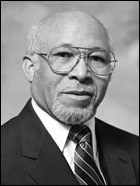Charlie Brady Hauser facts for kids
Charlie Brady Hauser (born October 13, 1917 – died November 11, 2007) was an important American educator and politician. He taught education at Winston-Salem State University in North Carolina for 21 years. He also served two terms in the North Carolina General Assembly, which is like the state's parliament.
Dr. Hauser is known for his brave stand against unfair rules. In 1947, he refused to move to the back of a bus because of his race. He called this the "second strike" against segregated travel in America. The "first strike" was by Irene Morgan, who also refused to give up her bus seat in 1944. Her actions led to a big decision by the Supreme Court of the United States. This happened more than 10 years before Rosa Parks' famous protest.
Contents
Early Life and Education
Charlie Brady Hauser grew up on a farm in Yadkinville, North Carolina. He was the third of thirteen children. He believed that helping to care for his many younger siblings taught him leadership skills. He also learned to work hard while doing chores and getting an education. He called his hometown a "no stop sign" segregated southern town.
Military Service and Higher Learning
Dr. Hauser served in the United States Army during a war. He spent 44 months fighting overseas. He was a Staff Sergeant and received several awards for his excellent service. These included a Good Conduct Medal and Five Battle Stars.
After the war, he used the GI Bill to continue his education. This program helps veterans pay for college. He earned his master's degree and a doctorate in education from the University of Pennsylvania. He also studied at The Catholic University of America and Texas Southern University. He wanted to become an officer in the Army but was denied, which he believed was due to racial discrimination.
His Stand on the Bus
In 1947, Dr. Hauser was traveling by bus from Winston-Salem, North Carolina to his teaching job. He refused to move to the back of the Atlantic Greyhound Lines bus. He knew that the Supreme Court had already ruled that people traveling between states did not have to follow state segregation laws. He felt it was his right as an educated citizen and a war veteran to sit where he pleased.
Arrest and Court Case
Because of his refusal, Dr. Hauser was arrested and put in jail. He remembered hearing angry shouts and threats, but he stayed calm. He later said that he focused on surviving, just like he did during the war.
After being released on bail, he planned his legal response. He considered suing for false arrest. He also hoped his case would challenge North Carolina's segregation laws. The judge ruled that his arrest was against the law. The judge said Dr. Hauser had the right to sit anywhere he wanted. The court ordered Atlantic Greyhound Lines to pay Dr. Hauser $2,000. He was very happy and used the money to buy a car, so he "didn't have to take the bus again!"
Following Brave Footsteps
Dr. Hauser's actions followed other brave people. A century before Rosa Parks, and 90 years before Irene Morgan, a schoolteacher named Elizabeth Jennings Graham was also removed from a horse-drawn New York City streetcar. She was a woman of color. She took her case to court and won.
Later Life and Legacy
Even though he was a member of the NAACP, Dr. Hauser preferred to help the Civil Rights Movement in his own way. He retired from teaching in 1977. He then served two terms in the North Carolina General Assembly in the early 1980s.
Dr. Hauser, a respected war veteran, passed away on Veterans Day at the age of 90.
His Thoughts on the Movement
Dr. Hauser often spoke about the fight for equal treatment in public transportation. He said that Rosa Parks' refusal to give up her seat in 1955 was the "third strike." He explained that by then, the laws were ready for change, people were ready, and leaders had developed.
He also said, "Irene Morgan was the first strike against the Jim Crow laws with her 1944 Virginia court challenge. There was no fanfare, just her fierce determination."


